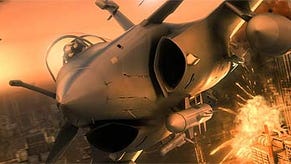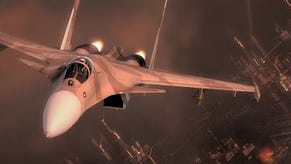Interview - HAWX 2's Edward Douglas
Tom Clancy novels are renowned the world over for plots thick with espionage, military science, and technologically detailed stories taking place during the Cold War era.
Games bearing his namesake are no exception, and the HAWX series is just the latest in a long line of Clancy licensed games like Splinter Cell, Ghost Recon, and Rainbow Six that give players a chance to delve into the shadowy world of bullets and military reconnaissance.
Set after the events of the first game, in HAWX 2, Ubisoft puts players back in the cockpit by sending you and your elite squadron to the Middle East where you are to investigate the disappearance of Russian nuclear weapons. Players will control three groups: American, British and Russian, each piloting various aircraft, including the F-22 Raptor, F-35 Lightning II and the Su-37 Terminator.
The game features a new night time precision targeted bomb and unmanned aerial vehicles, the ability to takeoff and land, improved graphics, a new damage system, and four player co-op along with "full adversarial multiplayer" with up to eight players.
The game's narrative director, Edward Douglas, had a chat with VG247 about all this and more during a recent preview event in London. Read on below the break to find out what all he had to say.
[Interview by Jem Alexander]
VG247: Could you tell us a little bit about who you are and what role you played in the development of HAWX 2?
Edward Douglas: I'm Edward Douglas, Narrative Director. I joined about half way through the project so I can't really call myself creative director. Coming in as Narrative Director halfway through this game, my role was to tell the story and try to bring a more cinematic, emotional feel that the first game didn't really have and really try to make you feel like you're a pilot in the cockpit.
In the first game you start a mission up in the air and you end it up in the air. You see this plane from a third person point of view the whole time. You never really felt like you're a real person in the real world, so we try to bring that to the game and really try to give that pilot experience.
VG247: It's nice that you're trying to bring the Tom Clancy franchise back to what it was always about -- strong storytelling.
Edward Douglas: He's a writer. His stories are about political intrigue, espionage and near future military technology and all of this is in the game. You'll be able to play a seek and destroy mission here – the nightvision one. This is part of a two part mission series in the campaign. You start off with aerial espionage, you're controlling a UAV (Unmanned Aerial Vehicle), which I teased in the presentation today. You're spying on conversations, tracking down part of a weapon smuggling network and creating a list of targets.
You're working with an agent on the ground who is actually a character from the same Russian spy organisation as one of the characters in Splinter Cell Conviction, Kestrel. So this agent, codename Wolfhound, is working with you and in the next mission you go under cover of night on a night time raid and take out this target. So, that's Clancy stuff –- far more than we could do in the first HAWX.
How does this UAV stuff play?
Edward Douglas: So there are some different levels that use it. Sometimes you track down vehicles, find targets and listen in on conversations. You have to make sure you use the right intel to find the right vehicles, lay down infra-red strobes which you can use to recognise those same targets in later missions. Things like that. It's actually been really cool as a narrative storyteller to have these story devices where you can interact from characters still from the air. It's still part of this aerial warfare experience, but it has a much wider palette than just a guy in a plane shooting missiles.
Did you find a lot of the new gameplay features coming from this new cinematic narrative?
Edward Douglas: A lot of the new gameplay features, honestly, came from the developers before I came on to the project. They looked at what was current in modern aerial combat these days. For example of course we're familiar, thanks to the media, with AC130 gunship support missions and precision bombing that features in the seek and destroy mission we have here today.
That's one of the most commonly used weapons in modern aerial combat because you want to make sure you're hitting very precise, discrete targets and not getting collateral damage. You don't want bad news to spread in the media that you hit a school instead of your target, so they brought that sense of authenticity into the game. And the UAVs (Unmanned Aerial Vehicles) of course. You hear news stories all the time about insurgent targets being taken out by unmanned drones and stuff. So all those new features are part of what's out there these days in the real world.
And real aerial dogfighting, the sort of thing you imagine and see in movies, doesn't really happen like that anymore. In reality the target is two kilometres away, you press a red button and something blows up. That might be completely authentic, but it's not fun. We're not a simulator game.
You've implemented take offs and landings, which was a big fan request from the first one.
Edward Douglas: Oh yeah, a fan request, but I think everyone on the team wanted to do it.
Was that technically difficult to implement?
Edward Douglas: I could ask the guys about that and get back to you. I don't actually know, but it's one of the most fun parts of the game as far as the new stuff. I think it's just great fun to play, to try and get those perfect landings. Especially the carrier landings where you're under fire in big sea battles.
Do they become more challenging to pull off the further you go in the game?
Edward Douglas: Yeah, landings and takeoffs actually. So a simple airstrip landing is okay. Then you've got a carrier landing, which is significantly more challenging because it's a much smaller target. Then you've got landings under fire, in the middle of a big battle, you've got 20% of health left, you're out of ammo, you've got missiles on your tail and you have to land, refuel, rearm and get back up in the air. Those are pretty intense – and then you've got takeoffs under similar circumstances, too.
How does the story differ from the first one? Did you go in with ideas of things you wanted to change?
Edward Douglas: To be honest I wasn't involved with the original conception for the story. I got brought in fairly late in production as the storyteller. So my goal was to take the story that was developed -- it's a traditional Tom Clancy, political intrigue story, but brought into the modern era of combat -- and tell it as best I could. So in terms of how the story was developed, I'm not the best guy to ask. You'll need to talk to someone who was there from the beginning.
As you play more of the missions you'll see it's not all from inside a cockpit. That's what I'm really trying to do, is to give the player a grounding as a real person, in a real room, in a real space. So then you get inside the plane and you take off and you understand so much more of the world that you're in. In HAWX 1 you spawn into a level in third person view and that's where it starts and ends. Being able to put the player on the ground, even in semi-interactive sequences, has been awesome for storytelling in terms of grounding the player.
You mentioned in your presentation that the graphical fidelity during low level flying is much better than in the original game. Is it still using the same satellite mapping?
Yeah, it's all GeoEye Satellite mapping. Phenomenal high-res textures and now we're able to populate the ground with so much more physical detail, too. So we can have missions and levels which take advantage of getting really low down to the ground.
In one of the missions here you have the opportunity to take out response fighters before they even take off. You're given the warning that they're trying to track you down and seek you out. You're in a stealth fighter and they know you're out there but you can try to bomb them on the runway, even. So there are more levels of tactics. There are other missions where you are on the ground trying to escape from various places.
There were some complaints in the first one about not being able to be in cockpit view for Assistance OFF mode. Was this taken note of for the sequel?
Edward Douglas: So in this game Assistance OFF mode is completely optional. Yeah, in HAWX 1 there were criticisms that some missions force you to use certain views. In HAWX 2's career campaign and multiplayer it's always a choice. You choose the mode that best suits your play style.
There are other series of missions outside of the main story -- different challenge modes -- that offer you different challenges and awards for different modes. So some missions will say 'try this mission with a special weapon pack and only in OFF mode', but those are special challenges. You're not forced to do those for the main story.
And then of course in multiplayer you can set up any kind of situations you want. You can have multiplayer with cockpit only, or OFF mode only for everybody.
When will the game be out?
Edward Douglas: The game will be available on September 3rd in Europe.
HAWX 2 is slated for PC, PS3, Wii and Xbox 360, with an unconfirmed date of September 7 for the US.










_ddwYK80.png?width=291&height=164&fit=crop&quality=80&format=jpg&auto=webp)



